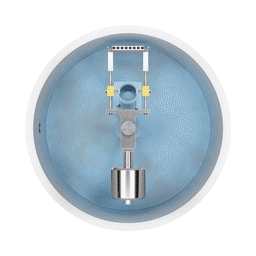TCE in Class A
Vacuum Centrifugal Casting Machines
TCE in Class A are robust and easy to use vacuum centrifugal casting machine especially designed to cast titanium, inconel, superalloys and other reactive metals.Main differences with respect to TCE in Class B are degree of vacuum, leak-back rate and ppm of oxygen that are admitted during the process, that makes the TCE in Class A the best solution for casting Titanium-based alloys and intermetallic alloys.
Also the choice of the vacuum pumps station and the induction power generator is different and it is chosen to get the maximum result in Titanium cast parts. Hence, TCE machines conceived in Class A are suitable for fields that require high quality control and low interstitial pick-up on the Ti cast parts, like Aerospace, Medical and Automotive.
Regarding the mold size and crucible capacity, today with TCE you can cast up to 2 kg Ti and use flasks with diameter up to 250 mm and length up to 380 mm.
TOPCAST also develops larger machines under customized specifications for what concerns Ti crucible capacity and Flask mould size. In case you are interested in getting a quotation for non-standard casting machine do not hesitate to send us your technical specifications.
Crucibles for Titanium have been designed to avoid alloy contamination and to withstand the high chemical and thermal shocks involved in Titanium melting.
TOPCAST also supplies special investment powder for Titanium casting particularly suitable to avoid alpha-case structure in the cast parts.
- Level of vacuum reached is extremely high
- Leak-back rate is carefully minimized
- Oxygen ppm in final atmosphere can be precisely measured and controlled
- Induction frequency and magnetic field intensity are specifically designed for reactive metals melting
- Cast Part traceability: These machines are provided with a Monitoring System based on a PC data logger which is taking process variable samples in both numeric and graphic form, making them available for the off-line Reporting program able to perform specific analysis and data comparison activities.
Technology & Features

Gas Wash Procedure
- Crucible and mould loading operation introduces oxygen
- The Gas Wash Purge procedure removes the oxygen (1) in a very fast and efficient way and then refills back the chambers with Argon, Nitrogen or Helium gas (2)
Melting
- Advanced Self Tuning thermoregulation (AST™) with exact temperature control of the molten alloys
- Accurate control of the temperature with a proprietary narrow band optical pyrometer or with rotating thermocouple
- Medium frequency induction heating stirs the melted alloy and leads to a perfect homogeneity
- Magnetic field frequency has been studied for best coupling and energy transfer
Injection and Compression
- When the charge is molten, the coil is retracted and the arm starts to spin.
- During the spinning the metal gets out from the crucible and enters the flask.
- Rotational speed profile, which controls the injection rate, can be regulated digitally for a consistent and reliable mould filling.
- The final speed will compress the tree during the solidification phase to reduce shrinkage porosity.
Tree protection after casting
- After the solidification phase, the flask cools down in a protective atmosphere to avoid oxidation.
- A blinking lamp will signal the operator that the cycle has ended and the flask can be removed.
Technical Data
(Customized models are available on request with special features)
| Laboratory machine | Production machine | ||||
| TCE8-Ti | TCE12-Ti | TCE40HD-Ti | TCE30-Ti | TCE50-Ti | |
| Working capacity | 100g Ti | 400g Ti | 400g Ti | 1000g Ti | 1700g Ti |
| Flask maximum diameter (mm) | Ø110 | Ø130 | Ø200 | Ø150 | Ø250 |
| Flask maximum height (mm) | 120 | 180 | 220 | 300 | 380 |
| Induction power | 8 kW | 12 kW | 40 kW | 30 kW | 50 kW |
| Max. spinning speed | 500 rpm | 400 rpm | 600 rpm | 300 rpm | 300 rpm |
| Vacuum pump | |||||
| Max. temperature | 2000 °C | ||||
| Monitoring system for process and production data collection | |||||
| Vacuum leakage detector | |||||
| Oxygen analyzer | |||||
| Remote assistance | |||||
| Optical pyrometer | |||||
| Camera pointed at crucible | |||||
| Rotating thermocouple | |||||
| Vacuum Chamber and Lid Water Cooled | |||||
| Automatic Arm Home Position for Robot Load / Unload operations | |||||
| Industry 4.0 | |||||
| Automatic Spin Trigger Algorithm | |||||








